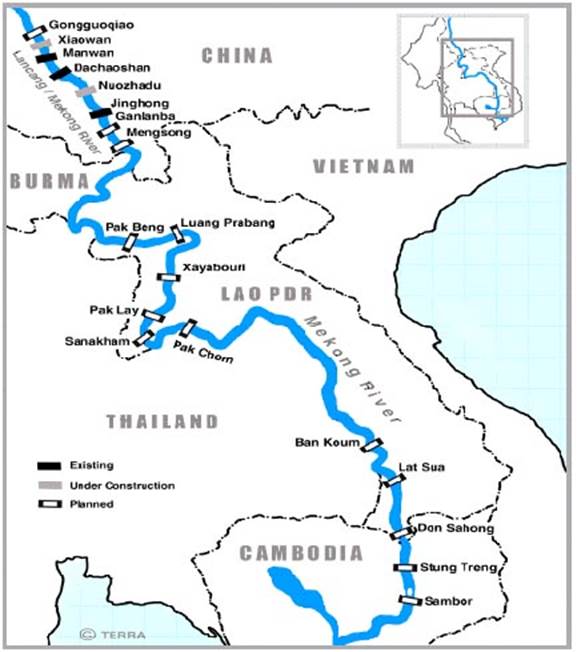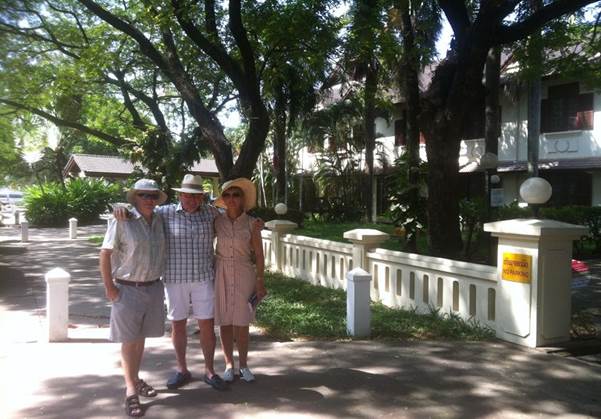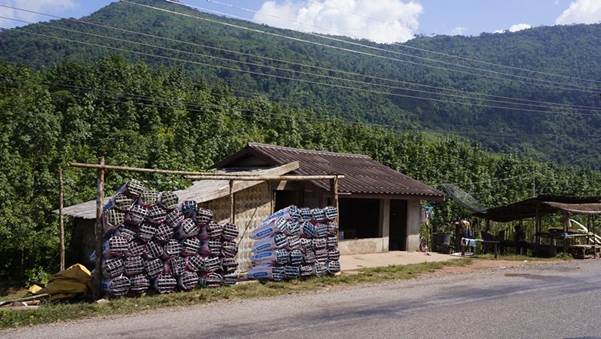31st October 2013 Mekong crossing from Thailand to Laos and Vientiane We had planned to visit this area at this time of the year with our long standing English sailing friends, John and Judy, just as they returned back to their boat in Phuket, after their 6 months back at their house in the UK during the Summer. We flew from Phuket to Udon Thani, in Northern Thailand, very close to the Laos border. There a taxi took us to the Thai border on the Mekong River, and another one took us across the bridge to the border control in Laos. 
Sunset crossing the bridge to the Laos border control Much of the country lacks adequate infrastructure. Laos has no railways, except a short link to connect Vientiane with Thailand over the Thai–Lao Friendship Bridge in this photo 
Picking up the forms that need completing to get the visa on arrival at the border control. The whole procedure only took about 30 minutes, then a taxi took us the 20 minute drive to the hotel in Vientiane, for a very small fee. 
Laos and it’s proposed Mekong River Dams About the size of the UK, Laos is completely landlocked, bounded by China, Vietnam, Cambodia, Thailand and Myanmar (Burma). Although 90 per cent of the country is mountainous, most life centres around the fertile Mekong River and its tributaries. The river irrigates rice paddies and provides some fish. However Laos is not self-sufficient in rice, and much food is imported from surrounding countries. Back in 1995, Cambodia, Laos, Thailand and Vietnam signed a treaty to create the Mekong River Commission (MRC), whose mission is to promote shared use of the river. The MRC’s first big test came in 2010 after Laos proposed to build the Xayaburi Dam. The consultations did not resolve disagreements over the project, and in 2012, Laos and Thailand defied neighboring governments and decided to proceed with the dam, despite ongoing opposition from Cambodia and Vietnam. Early work is now beginning in Laos on the second Mekong hydropower project, called the Don Sahong Dam. With two projects underway at speeds faster than the MRC diplomatic process can manage, the future of Mekong cooperation is uncertain. There is a risk that the dispute over the Mekong dams will escalate: not everyone can win, and the tradeoffs will be enormous. Billions of dollars are at stake, but so are the livelihoods of millions of people. Our trip across the mountainous area from Vientian to Luang Prabang gave us a first hand view of how the people are being affected by being shifted from the lowland valleys which will be flooded, to the highlands. Meanwhile, we had arranged to stay in a delightful colonial ‘palace’ hotel recently renovated in the centre of Vientiane town. We know the Manager, Jean Francois Luquer from when he owned a delightful French Restaurant called ‘Ma Maison’ on our local beach at Nayang in Phuket. He gave us a very warm welcome, and showed us the best places to eat and enjoy the ‘French’ food and evenings in town. 
John, David and Judy outside the Settha Palace Hotel in Vientiane The Boulangerie in Vientiane, selling baguettes and other French pattisseries 

Enjoying drinks in our suite at the Hotel 
John and David, Jean Francois, myself and Judy at the Highland Bar in Vientiane Where many expats enjoy the sunset over the Mekong River 

Next day we take a walk in the street outside the hotel, and visit some interesting shops selling artefacts and silver from Laos. The wine is a lot cheaper than Phuket as there is no tax, making it a great destination for the Thais to drive across the border! 
This is the Laos ‘Telecom’ Building, looking in dire need of renovation, with a couple of tuk tuk taxis outside it. The Presidential palace in Vientiane Beaux Arts styled. It was originally built to house the French colonial governors, and also served as a royal residence during the brief reign of the monarchy after independence. Since the royal family was banished in the 1970s, it is now mainly used for formal ceremonies. 
It loverlooks the Mekong River, here we are just waling along the Mekong the other side of the palace – this road is very new, nothing much built along the river yet! 

Peperino’s Restaurant, great food and wine, where we are served by the owner, a friend of Jean Francois Next morning, we are collected in a mini van by our Laotian friend, ‘Aiy’. He has also sailed on Bob’s boat with us between Phuket and Langkawi on an overnight trip, so we had got to know him quite well by then!  we stop by his home and say ‘hi’ to his wife ‘Good’ and their two girls. We first met him when they came and stayed in our spare house in Phuket in 2007, and the oldest girl was only 1! His Mum is married to our good friend Bob Bell, a sailing friend with a very famous boat called ‘Condor of Bermuda’. We met him in 2002 whilst we were in Fiji at the same time. Aiy, we stop by his home and say ‘hi’ to his wife ‘Good’ and their two girls. We first met him when they came and stayed in our spare house in Phuket in 2007, and the oldest girl was only 1! His Mum is married to our good friend Bob Bell, a sailing friend with a very famous boat called ‘Condor of Bermuda’. We met him in 2002 whilst we were in Fiji at the same time. Aiy, 

The scenery between Vientiane and Van Vieng was wonderful. Here we have stopped on a piece of land flattened out to make room for building village houses – they will have a great view! 

Aiy with his mini van – perfect to take us all and the luggage and deal with the mountainous roads 
The village houses selling charcoal – their only fuel. They do have electricity however, note the power lines. But Laos is banking on the anticipated returns from the $1.3bn Nam Theun 2 dam scheme, which was inaugurated in 2010 and is intended to generate electricity for export to Thailand, to boost its economy and infrastructure. A further significant upgrade to Laos' infrastructure is expected from the construction of the first high-speed rail line between China and Laos, on which work was due to start in early 2011. Public dissent in Laos is dealt with harshly by the authorities, and the country's human rights record has come under scrutiny. Laos denies accusations of abuses by the military against the ethnic minority Hmong. Hmong groups have been fighting a low-level rebellion against the communist regime since 1975. Of the people of Laos 67% are Theravada Buddhist, 1.5% are Christian, and 31.5% are other or unspecified according to the 2005 census.[1] Buddhism has long been one of the most important social forces in Laos. Theravada Buddhism coexists peacefully with the spirit worship and animism practiced among the mountain tribes. 
The Riverside Hotel, Van Vieng – drinks and snacks are served by the river after our 3 hour drive. | 
